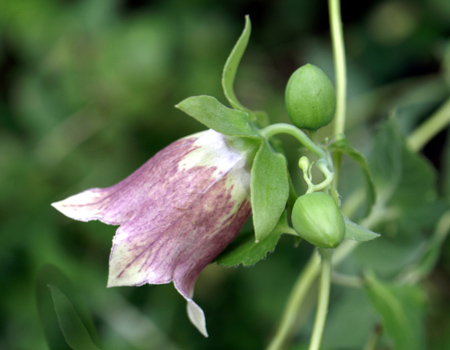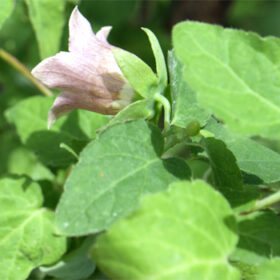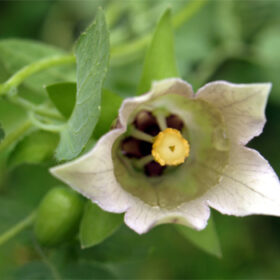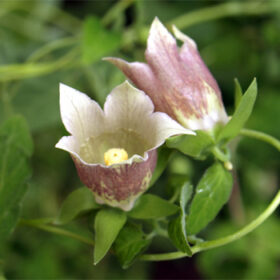Identification:
- Perennial herbs, with climbing stems reaching 2-3 meters in length and exhibiting numerous branches. The entire plant contains white latex.
- Tuberous roots, cylindrical, long, branched, fleshy, and pale yellow. Leaves are simple, opposite, ovate to heart-shaped, measuring 2-5 x 2-4.5 cm. They are thin, soft, and pale green, with white velvety hairs on the underside. Leaf margins are entire or have blunt teeth; petioles are 3-7 cm long.
- Flowers are solitary, axillary, bell-shaped, and white or slightly yellowish, with purple veins in the throat. The calyx has 5 lobes, lanceolate and pointed, slightly fused at the base. The corolla has 5 lobes, triangular and pointed. There are 5 stamens. The ovary has 5 locules.
- Berries, 5-angled, turn purple when ripe, and retain the calyx. Seeds are numerous, round, small, and yellowish-brown.
Biology and Ecology:
- Flowering occurs from May to July, with fruiting from July to September (or October). Natural propagation occurs through seeds. The ability to regenerate from remaining tuberous roots after harvesting is poor.
- The plant prefers moist, sunny environments but tolerates shade. It typically grows in fertile, humus-rich soils, within open spaces and along the edges of secondary forests, as well as in cultivated fields, at altitudes of 600-2000 meters.
Distribution:
- Vietnam: Lai Châu (Sìn Hồ, Phong Thổ), Điện Biên (Tủa Chùa), Lào Cai (Sapa, Bát Xát, Than Uyên), Sơn La (Mộc Châu, Mường La), Yên Bái (Mù Cang Chải), Hà Giang (Quản Bạ, Đồng Văn, Mèo Vạc, Yên Minh), Cao Bằng (Trùng Khánh, Trà Lĩnh), Bắc Kạn (Bạch Thông), Thái Nguyên (Tam Đảo), Lạng Sơn (Tràng Định), Hòa Bình (Đà Bắc, Mai Châu), Ninh Bình (Cúc Phương), Thanh Hóa (Son Bá Mười), Nghệ An (Mường Lống), Quảng Nam (Trà My), Kon Tum (Đắk Tô, Đắk Glei: Ngọc Linh), Lâm Đồng (Đà Lạt, Lạc Dương).
- Worldwide: India, China, Myanmar, Laos, Thailand, Indonesia.
Value:
- A valuable medicinal plant widely used in Vietnam. The tuberous roots are used as a tonic to treat weakness, anemia, jaundice, and indigestion.
Status:
- Frequently exploited for its tuberous roots for medicinal purposes. Deforestation for agriculture has directly led to a rapid reduction in the natural distribution range. Natural reserves are significantly depleted.
Classification:
- VU (Vulnerable)
- A1a,c,d + 2c,d
Conservation Measures:
- The species is listed in the Vietnam Red Book (1996) with the assessment “vulnerable” (Level V) and in the List of Endangered Forest Plants and Animals (Group 2) of Decree No. 32/2006/ND-CP dated March 30, 2006, of the Government to restrict exploitation and commercial use. It is necessary to thoroughly protect the natural populations of Campanulales in National Parks such as Cúc Phương and Hoàng Liên, and in the Du Già and Bát Đại Sơn Nature Reserves. Limit exploitation and rotate harvesting areas with a cycle of approximately 10 years. Further cultivation is needed in high-mountain regions; propagation is possible via seeds.




